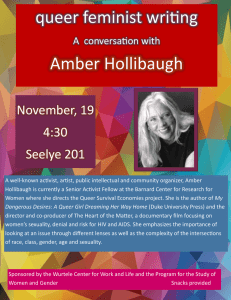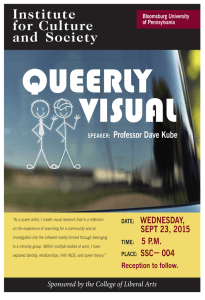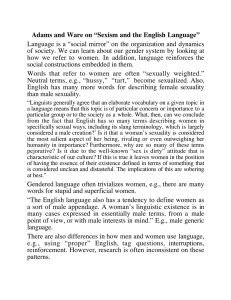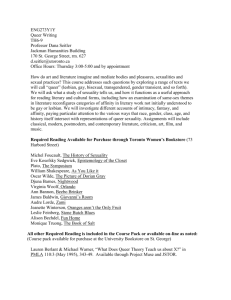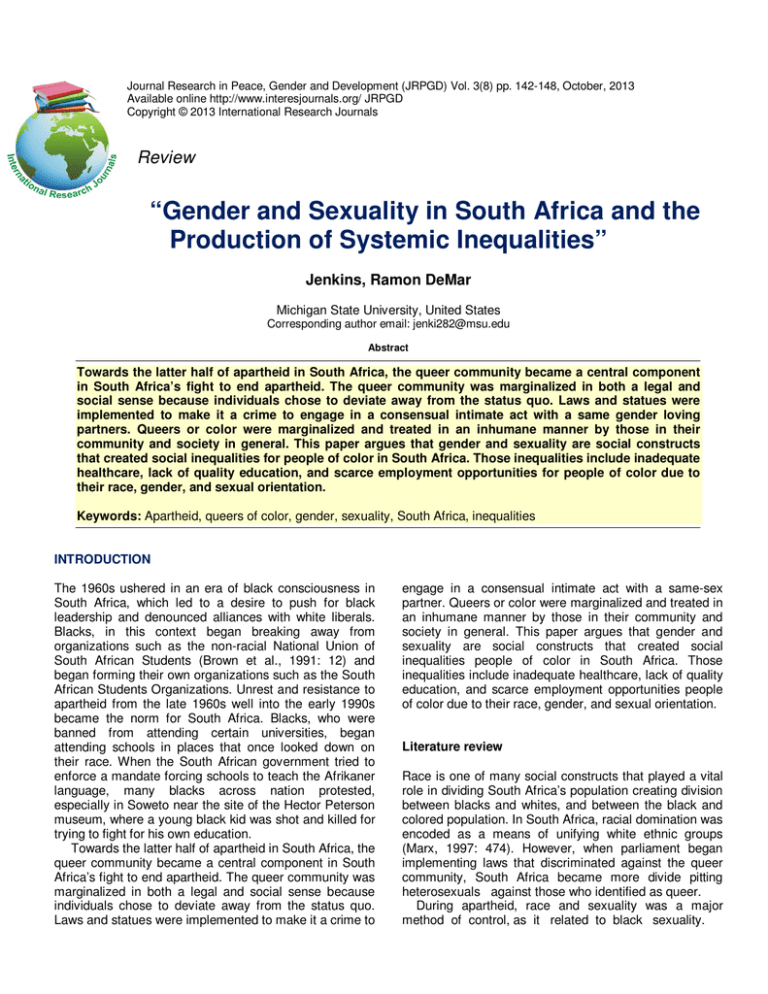
Journal Research in Peace, Gender and Development (JRPGD) Vol. 3(8) pp. 142-148, October, 2013
Available online http://www.interesjournals.org/ JRPGD
Copyright © 2013 International Research Journals
Review
“Gender and Sexuality in South Africa and the
Production of Systemic Inequalities”
Jenkins, Ramon DeMar
Michigan State University, United States
Corresponding author email: jenki282@msu.edu
Abstract
Towards the latter half of apartheid in South Africa, the queer community became a central component
in South Africa’s fight to end apartheid. The queer community was marginalized in both a legal and
social sense because individuals chose to deviate away from the status quo. Laws and statues were
implemented to make it a crime to engage in a consensual intimate act with a same gender loving
partners. Queers or color were marginalized and treated in an inhumane manner by those in their
community and society in general. This paper argues that gender and sexuality are social constructs
that created social inequalities for people of color in South Africa. Those inequalities include inadequate
healthcare, lack of quality education, and scarce employment opportunities for people of color due to
their race, gender, and sexual orientation.
Keywords: Apartheid, queers of color, gender, sexuality, South Africa, inequalities
INTRODUCTION
The 1960s ushered in an era of black consciousness in
South Africa, which led to a desire to push for black
leadership and denounced alliances with white liberals.
Blacks, in this context began breaking away from
organizations such as the non-racial National Union of
South African Students (Brown et al., 1991: 12) and
began forming their own organizations such as the South
African Students Organizations. Unrest and resistance to
apartheid from the late 1960s well into the early 1990s
became the norm for South Africa. Blacks, who were
banned from attending certain universities, began
attending schools in places that once looked down on
their race. When the South African government tried to
enforce a mandate forcing schools to teach the Afrikaner
language, many blacks across nation protested,
especially in Soweto near the site of the Hector Peterson
museum, where a young black kid was shot and killed for
trying to fight for his own education.
Towards the latter half of apartheid in South Africa, the
queer community became a central component in South
Africa’s fight to end apartheid. The queer community was
marginalized in both a legal and social sense because
individuals chose to deviate away from the status quo.
Laws and statues were implemented to make it a crime to
engage in a consensual intimate act with a same-sex
partner. Queers or color were marginalized and treated in
an inhumane manner by those in their community and
society in general. This paper argues that gender and
sexuality are social constructs that created social
inequalities people of color in South Africa. Those
inequalities include inadequate healthcare, lack of quality
education, and scarce employment opportunities people
of color due to their race, gender, and sexual orientation.
Literature review
Race is one of many social constructs that played a vital
role in dividing South Africa’s population creating division
between blacks and whites, and between the black and
colored population. In South Africa, racial domination was
encoded as a means of unifying white ethnic groups
(Marx, 1997: 474). However, when parliament began
implementing laws that discriminated against the queer
community, South Africa became more divide pitting
heterosexuals against those who identified as queer.
During apartheid, race and sexuality was a major
method of control, as it related to black sexuality.
Jenkins 143
People of color, who identified as queer, became a
kind of stock minor character in the pageant of
nationhood in the 1990s, embodying the arrival of a
radically new social order, and symbolically mediating
conflicts over race and class (Munro, 2012: ix). Sex
across the black-white racial spectrum was forbidden and
miscegenation was intensely stigmatized. Reinforced by
laws, which criminalized homosexuality, a deep-seated
and widespread homophobia deterred the open
expression or assertion of any sexuality. This was seen
as a transgression (Posel, 2004: 54). Apartheid laws
were strict, in that they literally created a second-class
citizenship status for blacks and coloreds living in South
Africa. This was especiallytrue for those who identified as
queer.
A person who identified as queer was not looked at as
the symbol of South Africa's democratic modernity due to
the fact that homosexuality has long been a western
phenomenon deeply contested and bound with the reimagining of race, gender, and nation in the steeped in
colonialism (Munro, 2012: viii). These constructs, along
with South Africa’s history, have been a complex
challenge for men and women w0ho identifies as queer.
South Africa in post-apartheid became more tolerant of
those who choose to live an alternative lifestyle. An
example of this was the new Bill of Rights introduced
South Africa’s legislature body.
These new rights
consisted of freedom of expression and a revision of law
dealing with censorship (Posel, 2004: 55). Moreover, the
implications of these new rights suggest that sexual
preference and gender equality was a matter of individual
freedom, and any sexual violence against sexual
preference or gender was a violation of those rights.
Theoretical framework
Sullivan (2003) asserts discourse surrounding and
informing sexuality is best understood in a cultural and
historical context, from both a hetero-normative and
queer perspective. This can be informed by queer theory.
Queer theory, which evolved out of the feminist
movement, implies gender is part of the self. Queer
Studies often use this post-structuralism theory as way to
examine socially constructed natures of sexual acts and
identities of same-sex relationships. Sullivan (2003)
argues that sexuality is a social construct of society
where “men who love men are understood as having a
female soul in a man’s body, and women who love
women as having a masculine psyche, or sex drive in a
woman’s body.” Although some individuals may look at
homosexuality in this particular manner, masculinity and
femininity is subjective, especially in context of how one
carries oneself and his/her own personal security as it
relates to notions of manhood and womanhood. As such,
homosexuality challenges hetero-sexist normative
hierarchy as it pertains to social norms that dominate
western culture.Such challenges have led to changes in
the interpretations and acceptance of the queer lifestyle.
Sartelle (1994) asserts that liberationists often argue
that homosexuality is congenital. He states, the reason
behind the shift is that the biological or no-choice model
of homosexuality allows gays and lesbians to be
accepted only by representing themselves as victims of
desires over which they have no control (Sullivan, 2003:
30). Oftentimes, the choice model is supported by
religious institutions, which argue that homosexuality is a
choice which often fuels anti-gay propaganda because it
supports the claim that if sexual orientation is a choice,
then it is possible for homosexuals to make the ‘right’
choice and to practice heterosexuality (Sullivan, 2003:
30). Thus, Butler (1990), Wittig (1991), and other Sullivan
(2003) support poststructuralist ideas; Wittig argues,
heterosexuality is a complex matrix of discourses,
institution, and so on that has become normalized in our
culture, thus making particular relationships, lifestyles,
and identities seem natural, a historical, and universal
(Sullivan, 2003: 39).
Because there is no consensus in the literature
regarding queer theory and homosexuality, scholars such
as Molefi Asante, Sr. (2003) and Frances Cress Welsing
(1991) both contend that homosexuality is a non-African
social construct of the west, and to engage in such
behavior jeopardizes Afro-centric principles of the black
community. Asante asserts that homosexuality and
lesbianism are deviations from Afro-centric thought
(Asante, 2003: 72) because it perpetuates a loss of black
manhood in black communities (Welsing, 1991). This loss
of black manhood in the black community is seen as
responsible for black racial suicide (Cole et al., 2003:
158). However, such assertions are not supported by
contemporary research, especially as it pertains to
countries in Africa.
In an anthropological study titled Male Daughters,
Female Husbands: Gender and Sex in an African
Society, Amadiume, describes in great detail how precolonial Igbo women often took on male roles in samesex marriages to demonstrate their affluence, and
exercise control over other women labor and
reproduction (Amadiume, 1987: 72). Therefore,
Amadiume argument and analysis of same-sex relations
in pre-colonial Africa debunks the myth that Asante puts
forth in his Afrocentricity manifesto that homosexuality is
a non-African phenomenon and practice, because same
sex relations has been a practice in Africa for quite some
time.
Although it has been proven time after time that samesex relations have always existed in Africa, some people
still choose to believe that homosexuality is un-African.
For example, in mid-1995 Robert Mugabe, President of
144 J. Res. Peace Gend. Dev.
Zimbabwe declares that gays are perverts and their
behavior is worse than that of pigs. Such views and
actions by the president encouraged the general
population to take the law into its own hands, to report,
arrest,
and deport
all
homosexuals because
homosexuality was seen in conflict with black culture
(Hoad, 2005: 200-201). Such homophobic statements
encouraged and acted as a breeding ground for violence
against the black African queer community. Such
violence have resulted in many black gay and lesbian
youth fleeing small conservatives cities within the South
Africa and flock to Johannesburg, a liberal city that is
more tolerant of queer individuals (Reid et al., 2002: 99),
even though some may argue that Johannesburg on
paper is liberal, but in practice not so much.
The historical and theoretical development of sexuality
in migration argues that the dual notion of sexuality
including one that is produced by the intersection of other
social identities such as class and race — queer studies
derived the idea that sexuality goes against the norms of
heterosexual institutions and practices (Manalansan,
2006: 224). As such, scholars suggest that gender and
sexuality have been socially constructed in that it
infringes negatively on those individuals whose lifestyle
challenges the hetero-normative status quo. Building
upon intersectionality scholarship — the study of race,
gender, class, and sexuality —hooks (1990), Collins
(1991), and Harper (1993) argue that homophobic
violence is, the subject of black masculinity and its
linkage with a lack of power within a racist and sexist
society (Reid et al., 2002: 101) perpetuates the status
quo with regards to homophobic violence. Such a
phenomenon coupled with an already strained economy,
where high levels of unemployment exist, results in black
men using violence as a way to assert power and control
over their own masculinity.
Social Construction of Gender and Sexuality
In today’s society, the term queer is used in a political
and theoretical sense that contends sexuality. Social
institutions and practices that normalize and naturalize
heterosexuality and heterosexual practices discipline this
contention. This includes but not limited to marriage,
family, and biological reproduction; and by marginalizing
people, institutions, or practices that deviate away from
the hetero-social norm (Manalansan, 2006: 225).
Manalansan’s definition of the term ‘queer’ is much more
inclusive of all LGBT individuals, and signifies the
intersectionality of identities, practices, and institutions,
mainly gender and sexuality
Gender and sexuality are two forms of social
constructs that place heavy emphasis on gender
performances and intimate acts of sex itself. This
research examines race, class, gender, and sexuality in
the context of producing global inequalities, with an
extreme focus South Africa. Inequalities addressed in this
research are the social and economic disadvantaged
queers of color face in a hetero-normative society, a
society that often tolerate queers, but still chooses to
shun and ostracize them due to their desire to live an
alternative lifestyle. Using queer theory, this paper argues
that cultural factors in Africa and HIV/AIDS pandemic
have contributed to tremendous amounts of inequalities
in healthcare, education, and employment as it pertains
to the social constructs of gender and sexuality.
A social constructions or institutionsare defined as an
inept concept of endurance that persists and is not
ephemeral (Martin, 2004: 1250). Oftentimes, when
gender acts as a social institution it is a concept that is
equated with control, facilitated by power. Martin (2004)
asserts sociologists equate social institutions with ideas,
norms, values, or beliefs with no attention to process or
practices (Martin, 2004: 1251). Institutions within a
society expect women to adhere to the domestic sphere
such as cooking, cleaning, and taking care of the kids.
Such societal expectations are constructed around
clusters of appropriate activities and procedures (Martin,
2004: 1251). Gender is socially constructed not only by
society, but also by institutions, which often filters into
public policy.
One such social construction is the construct of
religion. Religion is one of the biggest social institutions
that construct gender and sexual roles for men and
women. Religion is used to construct meanings and
symbols of sexuality and gender roles within African
communities. Patriarchy continues to have a domineering
effect on women’s role in African communities. Lawal
asserts, women in patriarchal societies, have suffered
various degrees of discrimination, segregation, inequality,
oppression and marginalization (Lawal, 2011: 271) thus
limiting many women’s economic, political, educational,
and religious aspiration. Sexuality has many different
definitions and is often placed into cultural contexts.
When discussing gender and sexuality in a broad
context, society uses the generic definitions of sex and
gender. Sex refers to the female and male physiology
and their respective sex organs, while gender refers to
the roles attributed to men and women in society (Lawal,
2011: 272).
Moreover, the physical act of sex involves penetration
and sexual practices that involves anal or oral sex.
Therefore, “sexuality encompasses a set of ideas,
meanings, and social practices such as sexual behavior
monogamy, polygamy, and polyandry. While sexual
identity includes heterosexual, homosexual, bi-sexual,
trans-sexual, sexual desire; sexual relations, and sexual
politics (Lawal, 2011: 273), this also includes religion.
Jenkins 145
Both Christianity and Islam are two of the biggest
religious institutions that preach about the subjugation of
women, marriage, divorce, and inheritance. Both religious
institutions speak to the dichotomy of men and women,
drawing a distinct line between both genders and
sexuality.
Moreover race, according to leading scholars Collins
(1991); Bell (1992); Crenshaw (1995), suggest that race
is a social construct, which filters into public policy.
However, Devon Carbado argues that gender and
sexuality are negotiated in black anti-racist politics when
that negotiation manifests itself in a specific context
(Carbado, 1999: 12-13). He further contents that black
men often posit themselves into the discourse about
gender and sexuality deploy patriarchy to the service of
anti-racism, and defend patriarchy as being vital to the
interest of the black community (Carbado, 1999: 13).
Such arguments foster a relationship between racism and
homophobia. However, such anti-racist discourse
separates the two phenomena’s and marginalize gay
blacks and lesbians differently.
Therefore, according to (Carbado, 1999: 26), racism
and homophobia, perpetuates the notion that blackness
— does not exist outside of gender or sexual orientation
(when in all actuality all three identities co-exist
simultaneously. For example, a heterosexual black man
is never put in the position to choose between the
ontology of being a man and being black at the same
time; or being a black and being a heterosexual
simultaneously (Carbado, 1999: 25). However, black gay
men or lesbian women are not afforded the same
opportunity as their heterosexual peers. Carbado argues,
to be a strong heterosexual black man [or woman] is a
good thing; but to be a strong emasculating black woman
[or effeminate black man] quite typically is damaging
(Carbado, 1999: 25). Because homosexuality is such a
taboo subject, gay men that exhibit effeminate tendencies
are subject to extreme cruel treatment by peers because
of how they choose to express their gender performance.
Therefore, black gay men are subjected to lead a
closeted lifestyle and engage in what is called passing to
play up their masculinity.
The performance of passing is defined as both a
means of maintaining cultural membership, by assuming
the necessary performance strategies that signal
membership, as well as the conscious and unconscious
choice to engage other performance that situate racial
[and cultural] identity (Alexander, 2006). For example, a
closeted gay ‘straight-acting’ man will talk about having
sex with multiple women around his male peers to avoid
the social and cultural strictures against homosexuality
(Alexander, 2006). However, bisexual men are somewhat
an exception to the rule. There are times when a bisexual
man may have a girlfriend, or a wife, but will mess around
with other bisexual men on the side, individuals who are
also in committed relationships with women. Many people
associate such a lifestyle with the down low phenomenon
that often receives most of the blame for the high
HIV/AIDS rate in the black community among
heterosexual women. Overall, passing is a cultural
performance used in the gay community, of which
success largely depends on not overacting, which would
call attention to the fact that a performance is actually
being used (Alexander, 2006).
In Cool Pose: the Dilemmas of Black Manhood in
America, Majors and Billson argue, “Being cool or
adopting a cool pose is a strategy that men use to make
sense of their everyday lives” (Majors et al., 1992). Acting
cool has always played a vital role in the formation of
masculinity. Youth today use “coolness as a mask [to fit
in which contributes] to the high dropout rate among
black males, and heightens their chances of engaging in
substance abuse and juvenile delinquency” (Majors et al.,
1992). Cool pose entails a multitude of advantages and
disadvantages. ‘Cool’ masculinity,
Contributes to black masculinity in ways that includes
dynamic and positive qualities such as dignity, respect,
control, self-esteem, and social competence it helps
protect the black man’s self-image and enables him to
cope with assaults on manhood. Ironically, cool pose can
inject strain into his most intimate relationships, get him in
trouble with authorities, and reinforce an aloofness that
stems from living too far from his deeper emotions
(Majors et al, 1992).
In other words cool pose is about the way a black men
use different patterns of speech, walk, and demeanor to
maintain a sense of social competence to protect himself
in the streets and against authority figures such as law
enforcement and his employer. Cool pose gives agency
to the marginalized masculinity and is used as a coping
mechanism to the racist ideology that hegemony
masculinity imposes on black masculinity. Moreover,
hegemonic masculinity reasserts an identity that gives
control to black men in a society that is continuously
being restructured to favor the status quo.
To this end, social construction of masculinity and its
impact on gay men contends that masculinity is
constructed in terms of maleness, muscularity, sexual
aggressiveness, and virility (Halkitis, 2000: 130).
Perception of what it means to be masculine is commonly
associated with a man’s physique, the concept of the
masculine male is reserved for the heterosexual man
(Halkitis, 2000: 131) and not his homosexual peers.
Moreover, gay men are stereotyped as being effeminate,
and Western society does not account for same-sex
attraction as being masculine. Most straight acting gay
men don’t want to be linked with effeminate behavior or
an effeminate acting man in the hearts and minds of their
friends and family (Kendall et al., 2006: 32). Therefore, to
achieve standards of masculinity, gay men often spend
146 J. Res. Peace Gend. Dev.
countless hours grooming them self to appear more
masculine such as spending endless hours at the gym,
cutting their hair razor-short, getting tattoos, and
piercings. However, gay HIV-positive men often tie
perceptions of masculinity to keeping their bodies strong,
functional, and dispelling the myth that all gay HIVpositive men look sickly.
Access to Limited Healthcare
Access to adequate health in African nations is often a
complex socio-political issue, especially for the queer
community and those affected by the Human
Immunodeficiency Virus and the Acquired Immune
Deficiency Syndrome. Economic poverty and sexual
exploitation goes hand-in-hand as it pertains to the
treatment of the HIV/AIDS crisis across Africa.
Oftentimes, people in Africa are relegated to depending
on philanthropy to gain access to healthcare treatment
more in developing countries whose citizens are able to
rely on social welfare programs (Heimer, 2007: 551).
Furthermore, governmental agencies dictate the
international flow of resources, which further contributes
to the institutional context of how HIV-positive patients
treated for the sexually transmitted infection. Thus, the
micro and macro, institutional governmental practices
hinders who is able to gain access to life-prolonging
drugs, how those drugs are paid for and priced; most
importantly, how patients receive treatment from clinics.
The nation-state and its relation to broader international
market have fundamentally controlled healthcare
inequalities.
Nation-state governments have attempted to control
their country’s gay population by instituting discriminatory
sodomy laws that local law enforcement used to police
the gay community. Traditionally, sodomy laws have
been used to criminalize, formulate, maintain, and control
the social norms and consequent effects on individual
behavior. Sodomy laws, even when unenforced,
expresses contempt for certain classes of citizens [they]
infringe on anyone’s liberty to engage in particular sexual
practices (Goodman, 2001: 646). Sodomy laws infringes
on the liberty and privacy of two consenting adults, who
engage in an intimate encounter with one another.
Moreover, it violated many queer individuals’ eighth
amendment constitutional rights. Sodomy laws became a
chief systematic way of South African society as a whole
to let black gay men know that they were the scum of the
earth (Goodman, 2001: 654). South Africa legality system
during the latter half of the apartheid era is a good
example of how sodomy laws affected the queer
population.
Africa’s governmental response to the HIV/AIDS; more
importantly, rhetoric used by African heads of state.
Oftentimes, use rhetoric in political policies and strategies
that make it seem like the HIV/AIDS pandemic is not as
much of a human catastrophe. Public and private
debates in Africa pertaining to Western political and
scientific agencies role in solving the HIV/AIDS pandemic
in Africa often ignore African views and perspectives, and
have gone as far as to even silence the African on
occasions (Ige et al, 2012: 3). People living in Africa often
look to their respective nation-state the institution
responsible for the management of geo-political space
and allocating resources to meet those societal needs
(Ige et al., 2012: 10). Public health services are one of
many resources that that nation-state is responsible for
providing to its citizens.
However, there are concerns with the state of Africa
public health system given the continent’s history with
colonialism, the way foreign aid is distributed to the
respective states. First, the reshaping of states through
structural adjustment programs often resembles
neocolonialism. Second, citizenship, which is controlled
by the national government or lack thereof, which poses
a problem for those who are citizens of the state, but lack
proper identification. Post-apartheid South African
citizens who do not possess identity documents are
frequently denied access to public health and social
services in their own country” (Ige et al., 2012: 11). If a
citizen lacks proper identification, the healthcare system
acts very dismissive of those citizens as if they are
foreigners in their own country. Furthermore, even if they
do have proper identity documents healthcare has been
tampered with so much by the promotion of private
healthcare services (Ige et al., 2012: 11), and those who
have formal employment benefit the most.
The global drug gap between “rich and poor countries
arises from multiple market and government failures as
well as from huge income difference” (Reich, 2000:
1979). Access to adequate pharmaceutical health care is
very controversial in developing countries. For example,
anti-retroviral drugs, which are essential for treating HIVpositive patients, have decreased by 48% in the U.S. in
the late 1990s, while most of those infected with HIV
worldwide continue to live in poor developing countries.
In 1998, 67% of those living with HIV/AIDS lived in poor
developing countries located in sub-Saharan Africa
where 80% of HIV/AIDS patients (Reich, 2000: 1979) die
because of inadequate access to essential drugs. Those
who live in poor developing countries in Africa often face
structural inequalities within the healthcare market which
many times places a limit on their need for adequate
healthcare treatment.
Cultural Factors in Education
Cultural factors in Africa often lead to educational
inequalities as it pertains to the HIV/AIDS pandemic.
Jenkins 147
Orphan-hood status, household socio-economic status,
and child school enrollment across low-income countries
are all factors contribute to educational inequalities.
Orphan-hood in developing countries is predicated on
overall poverty rate, socio-economic status of the
household, adult mortality, customs and demographic
factors such as child fostering and the extended family,
existing demand for child schooling, and public policies
that are already put in place (Ainsworth et al., 2006:
1100). While adult mortality from other infectious
diseases disproportionately affects the poor, AIDS strikes
both the poor and the non-poor.
Many times the educational system in South Africa
has contributed to social constructions of gender and
sexuality.School children's understanding of the AIDS
crisis and the impact it has on gender and sexuality has
been articulated against the backdrop of race and class.
Children that were observed for this study were between
the ages of six and eight years old. Although children are
innocent as it pertains to sex and sexuality, many have
demonstrated a good understanding about the
construction of gender, sexuality, and HIV/AIDS all
together. Children in this study were able to deploy
knowledge of healthy eating and living, to defend
themselves against the possibility of becoming infected
(Bhana et al, 2007: 119). Furthermore, many kids were
well aware of how dangers that high sexual-risk
behaviors such as engaging in promiscuity and not using
protection increases the risk of contracting HIV/AIDS.
To understand the ways in which gender and sexuality
has been featured in the teaching methods of South
African primary schools, Bhana (2009) compared two
schools located in Durban, South Africa. Bhana focused
on primary school educator's teaching methods and
strategies to educate elementary South African school
children about preventing the spread of HIV/AIDS. In
2005 a Human Science Research Council study
estimated the breakdown of Durban; South Africa
HIV/AIDS prevalence rate to be 13% for blacks; 1.9% for
coloreds; 1.6% for Indians, and 0.5% for whites” (Bhana,
2009: 167). Social forces were contributing factors to
such a high HIV/AIDS prevalence rate are structural
inequalities
such
poverty,
racial
and
gender
discrimination. Bhana asserts, kids who are the most
socially and economically disadvantaged (Bhana, 2009:
168) are at a greater risk for contracting the disease due
to the discourse of childhood innocence.
Furthermore, Bhana recognized that HIV prevention
measures in elementary schools were limited because
teachers oftentimes omitted the fact that having
unprotected sexual intercourse can increase the risk of
contracting the sexually transmitted disease. Instead,
many primary school teachers focus on the biomedical
aspect of the disease instead of providing discourse on
life skills.
Children that were observed for here 2009 student were
between the ages of six and eight years old. Although
children are innocent as it pertain sex and sexuality,
many often demonstrated a good understanding about
the construction of gender, sexuality, and HIV all
together. The kids in this study were able to deploy
knowledge of healthy eating and living, to defend
themselves against the possibility of becoming infected
(Bhana et al., 2009: 119). Furthermore, many kids were
well aware of how dangers that high sexual-risk
behaviors such as engaging in promiscuity and not using
protection increases the risk of contracting HIV/AIDS.
Inequalities in Employment
Structural inequalities like high unemployment coupled
with high rates of HIV/AIDS for black men contributes to
individual inequalities as it pertains queer of colors being
discriminated against because of their levels of
masculinity and their gender performance. The macroeconomic aspect of the HIV/AIDS pandemic in Africa
posits that as many as one in three adults in some
African countries are infected with HIV/AIDS (Tavrow et
al., 2008: 75). This tragic statistic affects the institution of
the family, the agriculture sector, and the business sector
in various ways. HIV/AIDS is continues to destroy
families and very often children to become orphans at an
early age.
The agricultural sector is hit hard because families are
not able to farm effectively thus contributing to lower crop
yields and food insecurities” (Tavrow et al, 2008:75).
Thus, HIV/AIDS is the main culprit in killing off mass
amounts of skilled workers and many businesses pay
higher insurance premiums for their skilled workers
because of absenteeism, while experiencing a reduction
in productivity. Adults most likely to be infected were
those who were mobile such as traders, businessmen,
fishermen, and transportation workers, not just the poor
(Ainsworth et al., 2006: 1101). Workers like these many
times do not have access limited or no access at all to
adequate health care because their jobs often keep them
on the move.
The tertiary sector which isthe apex of the educational
and medical institutions the training ground for the next
generation of political leaders, managers, educators,
researchers, doctors, lawyers, journalists, and other
professionals (Tavrow et al., 2008: 76-77) are suffering
dramatically because of low retention rates for personnel
and the limited amount of resources. Much of the
problem is due to brain drain, which cause a ripple effect
throughout Africa’s economy. For example, America
tends to recruit the best and the brightest of Africa’s
educators, researchers, and medical personnel. Many
Africans who are educated in America, oftentimes remain
148 J. Res. Peace Gend. Dev.
in America after graduation because of better economic
opportunities, juxtapose to returning to their original
country of origin.
CONCLUSION
In summary, gender and sexuality have been socially
constructed in Africa. This social construction has created
many inequalities for those individuals who identify as
queer. Access to adequate healthcare, quality education,
and better employment opportunities all play a vital role in
shaping the dynamics of how queers of color and those
affected by the HIV/AIDS virus. Both political figures and
public policy makers should move to practice and design
better strategies that address all three aspects of Africa
political economy in order to give every citizen of Africa,
especially those black queer citizens of South Africa a
better quality of life.
As scholars suggests intersectionality continues to
dominate structural inequalities. This continues to create
a socio-economic disadvantage for those who identify
with certain race, gender, class, and sexual orientation in
the contemporary period. Furthermore, the HIV/AIDS
pandemic has gotten way out of control. Both
governmental and non-governmental organizations need
to come together to figure out an effective strategy of
talking about the pandemic if they are serious about
eradicating the disease. Although people of color who
identify as queer are protected under South Africa new
constitution in some instances, there’s a greater need for
future research that addresses gay rights so that queers
of color are accepted as a group of human beings rather
than tolerated on paper and marginalized in practice.
Post-apartheid has given the African National
Congress an opportunity to commit to gender equity and
queer rights. The mass media in particular, such as
South African soaps, which air throughout the day and
into the night, have begun to integrate queer characters
of color into their storylines. The integration of nonpathological gay characters in the soap Isidingo is
evidence of remarkable transformation of the country’s
mass media in the wake of apartheid demise (Barnard,
2006: 48). Such a move challenges the political discourse
of the country’s past and tolerance of those who choose
not to abide by hetero-normative standards in society.
REFERENCES
Ainsworth, M., Filmer, D. (2006). “Inequalities in Children Schooling:
AIDS, Orphan-hood, Poverty, and Gender.” World Development. 34
(6): 1099 – 1128.
Alexander, B. K. (2006). Performing Black Masculinity: Race, Culture,
and Queer Identity. Lanham: Rowman and Littlefield Publishers.
Amadiume, I. (1987). Male Daughters, Female Husbands: Gender and
Sex in an African Society. London: Zed Books.
Asante, M. K. (2003). Afrocentricity: The Theory of Social Change.
Chicago: African American Images.
Barnard, I. (2006). “The Language of Multiculturalism in South African
Soaps and Sitcoms.” J. Multicultural Discourses. 1 (1): 39 – 59.
Bergling, T. (2006). “Sissy-phobia and Everything After,” in Gendered
Outcasts and Sexual Outlaws: Sexual Oppression and Gender
Hierarchies in Queer Men’s Lives. Edited by Christopher Kendall and
Wayne Martino. New York: Harrington Park Press.
Bhana, D. (2009). “They’ve got all the Knowledge’: HIV Education,
Gender, and Sexuality in South African Primary Schools.” British J.
Soc. Edu. 30 (2): 165 – 177.
Bhana, D., Epstein, D. (2007). “‘I Don’t Want To Catch It’: Boys, Girls,
& Sexualities in an HIV/AIDS Environment.” Gender and Education.
19 (1): 109 – 125.
Bozzoli, B., Delius, P. (1991). “Radical History and South African
History,” in History from South Africa: Alternative Visions and
Practices. Edited by Joshua Brow, Patrick Manning, Karin Shapiro,
and Jon Wiener. Philadelphia: Temple University Press.
Carbado, D. (1999). Black Men on Race, Gender, and Sexuality: A
Critical Reader. New York: New York University Press.
Cole J.B., Guy-Sheftall, B. (2003). “Black, Lesbian, and Gay: Speaking
the Unspeakable” in Gender Talk: The Struggle for Women’s Equality
in African American Communities. New York: Ballantine Books. 154 –
181.
Goodman, R. (2001). “Beyond the Enforcement Principle: Sodomy
Laws, Social Norms, and Social Pan-Optics.” California Law Review
89 (3): 643 – 740.
Halkitis, P. N. (2000). “Masculinity in the Age of Aids: HIV-Seropositive
Gay Men and the ‘Buff Agenda,’” in Gay Masculinities: Research on
Men and Masculinities. Edited by Peter Nardi. Thousand Oaks: Sage
Publications. 130 –151.
Heimer, C. A. (2007). “Old Inequalities, New Disease: HIV/AIDS in SubSaharan Africa.” Annual Review of Sociology 33: 551 – 577.
Hoad, N. (2005). Sex and Politics in South Africa: The Equality Clause,
Gay and Lesbian Movement, and the Anti-Apartheid Struggle. Cape
Town: Double Storey Books.
Ige, S., Quinlan, T. (2012). African Responses to HIV/AIDS: Between
Speech and Action. Scottsville: University of KwaZulu-Natal Press.
Lawal, A. A. (2011). “Sexuality, Religion and Spirituality,” in Gender,
Sexuality, and Mothering in Africa. Edited by Toyin Falola and Bessie
House-Soremekun. Cape Town: Africa World Press.
Manalansan IV, M. F. (2006). “Queer Intersections: Sexuality and
Gender in Migration Studies.” International Migration Review 40 (1):
224 – 249.
Martin, P. Y. (2004). “Gender as a Social Institution.” Social Forces 82
(4): 1249 – 1273.
Marx, A. W. (1997). “Apartheid’s End: South Africa’s Transition from
Racial Domination.” Ethnic and Racial Studies 20 (3): 474 – 496.
Munro, B. M. (2012). South Africa and the Dream of Love to Come:
Queer Sexuality and the Struggle for Freedom. Minneapolis:
University of Minnesota Press.
Posel, D. (2004). “‘Getting the Nation Talking About Sex’: Reflection on
the Discursive Constitution of Sexuality in South Africa since 1994.”
Agenda. 62 (2): 53 – 63.
Reich, M. R. (2000). “The Global Drug Gap.” Science. 287: 1979 –
1981.
Reid, G., Dirsuweit, T. (2002). “Understanding Systemic Violence:
Homophobic Attacks in Johannesburg and its Surrounds.” Urban
Forum. 13 (3): 99-126.
Sullivan, N. (2003). A Critical Introduction to Queer Theory. New York:
New York University Press.
Tavrow P, Omwami EM (2008). “The Impact of HIV/AIDS on Tertiary
Education and Health Sectors in Africa,” in HIV/AIDS in Africa:
Challenges and Impact. Edited by Edith M. Omwami, Stephen
Commins, and Edmond J. Keller. Cape Town: Africa World Press.
Welsing, F. C. (1991). The Isis Papers. Chicago: Third World Press.

